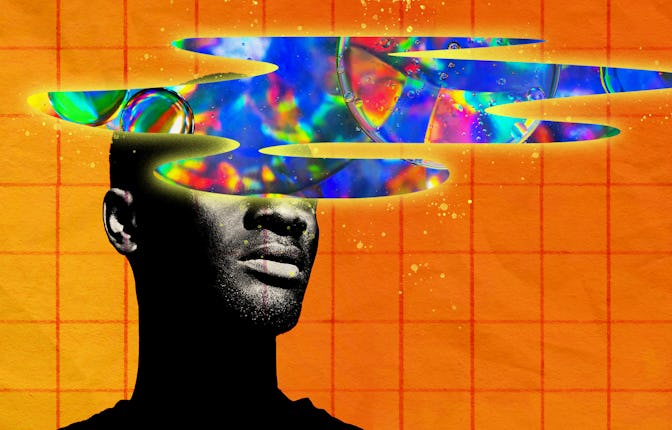Could a VR “trip” offer a sober shortcut to the healing potential of psychedelics?
A psychedelics researcher separates the science from the hype.

Especially amid the existential dread of our current COVID hellscape, people have increasingly turned to psychedelics as portals to empathy and enlightenment. Tech bro hype aside, though, they’re not for everyone. Tripping isn’t recommended for those with severe heart disease or who show signs of schizophrenia and related disorders. Many others are simply unprepared for the intensity of a full-blown trip.
But what if you could unlock the same altered state of consciousness that psychedelics do — as well as their potential to treat PTSD, major depressive disorder, and other mental health conditions — whilst completely sober?
Some virtual reality experiences could offer just that. The extremely buzzy meditation app Tripp allows you to float through celestial bodies, fractals, and other awe-inspiring scenes. The University of Sussex’s Hallucination Machine mimics the swirling hallucinations triggered by classical psychedelics like psilocybin (the main compound in shrooms) and LSD. Meanwhile, Atlas V’s Ayahuasca, Kosmik Journey immerses users in pulsing, kaleidoscopic images, similar to those created by the hallucinogenic brew.
While tripping sans drugs is an intriguing possibility, I can’t help but be skeptical. Sure, VR can replicate the auditory and visual aspects of a trip. But what about its intensely spiritual, ineffable profundity, which also seems important for the psychological healing that psychedelics promise? I spoke with Matthew Johnson, a professor of psychiatry and behavioral sciences at Johns Hopkins Medicine, about the extent to which VR apps can mimic psychedelics — and their therapeutic potential.
To definitively respond to this line of inquiry, “what you’d really need is the study comparing the two [psychedelics and VR] head to head,” says Johnson, who researches the effects of psychedelics. Even studies that look at them separately, but under similar conditions, would provide more clarity. Scientists still have yet to conduct them, though, Johnson tells Mic.
But as it stands, “I highly doubt whether an app alone is going to approximate the magnitude of the efficacy of psychedelic therapy,” he says. That’s partly because VR can only directly manipulate the perceptual, but not the emotional, aspect of a trip.
It’s the emotional aspect — especially the mystical experience observed at higher doses, which can include revealed truth and ineffability, among other powerful qualities — that seems to underpin psychedelics’ therapeutic potential. Studies have correlated it with long-term positive outcomes for treatment-resistant depression, lowered depression and anxiety in cancer patients, and greater likelihood of quitting smoking, for example.
People have highly emotional experiences on 5-MeO-DMT (derived from the venom of the Bufo alvarius toad), even if it’s less visual than DMT (the main active ingredient in ayahuasca) — suggesting that “maybe you won’t get a meaningful effect from just the perceptual effects,” Johnson says. “But perhaps you do.” It’s also possible that the perceptual effect contributes to the emotional effect. At this point, we just don’t know.
That said, the therapeutic results have been so large in preliminary studies of psychedelics that “even if you had an effect that was a quarter of that size, that’s still important to pursue,” Johnson says. To his knowledge, no studies have investigated whether VR can offer the same mental health benefits psychedelics have shown.
For people advised to steer clear of psychedelics, VR may offer a safer alternative, unless it does end up closely mimicking a trip, in which case it, too, could spur a panic reaction. But that seems less likely, Johnson says — and you can always remove the headset if it all feels like too much. In contrast, you’re stuck tripping, no matter how badly you want to stop. VR would also allow you the flexibility to program your experience, maybe transition to a beautiful field of flowers to calm yourself down, or crank up the intensity if you’re ready. “You want to test these things, but it’s reasonable that it [VR] would be, relatively speaking, safer than psychedelics,” Johnson says.
Trippy VR experiences might seem like psychedelics lite.
While Johnson believes it’s worth testing VR experiences that seek to recreate a psychedelic trip on their own, he’s also exploring using them alongside psychedelic therapy. In a study slated to start in a month or two, he and his colleagues will compare participants’ self-reports about their creativity and engagement with their professional work during portions of psilocybin-assisted therapy sessions with and without VR.
Rather than an app designed to mimic a trip, Johnson and his team will experiment with various images to see how they influence participants’ psychedelic experiences. (Maybe, say, exploding fireworks won’t have an effect, but nature scenes will.) They hope to determine whether VR can enhance them — in other words, whether participants will find these experiences more meaningful with VR than with psilocybin alone.
In a similar vein, Tripp and PsyAssist — a company acquired by Tripp that creates digital psychedelic therapy tools — plan to release a product that would let providers and patients use VR, augmented reality, and mobile technology in ketamine-assisted therapy, Forbes reported in August.
While trippy VR experiences might seem like psychedelics lite, the bottom line is that they come with both promise and risk, just like the real thing, according to Johnson. To an optimization-obsessed generation constantly in search of “brain hacks,” a sober shortcut to the healing potential of psychedelics has massive appeal. But “we need to follow the data,” Johnson says, “rather than what we hope is going to work.”